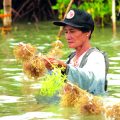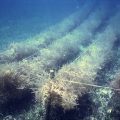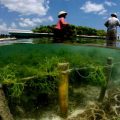It is unlike any sunken treasure anyone has ever discovered underneath the ocean. But its value outweighs that of a chest overflowing of gold. Seaweed is the ocean’s valuable deep sea vegetable. During the ancient times, it was only served to kings and their honoured guests. It has been considered a miracle crop and it doesn’t fail to live up to the name. The ocean water is full of nutrients and where else can these nutrients be concentrated in but to seaweed? Seaweed is rich in minerals like calcium and iodine while also having a low amount of calories. Seaweed detoxifies our bodies. They help prolong one’s life by regulating the acid levels in our blood and in improving our bodies’ disposal of toxins.
In the Philippines, Ms. Aida Andayog of the Bureau of Fisheries and Aquatic Resources (BFAR) Region 5, has been working on seaweeds ever since the Bureau of Agricultural Research (BAR) assisted in funding her CPAR project on seaweeds in 2003. She, along with her team from the Tobaco Faith International Church, developed the existing methods of harvesting seaweeds and eventually ventured in creating seaweed-based products.
Today, seaweed technology has already been developed and enterprises have already emerged featuring a wide array of products. Ms. Andayog is currently on the process of developing their brand and processing plants in the Bicol region.
Through her research, Andayog has managed to come up with a wide array of ways in cooking dried seaweed. One example is seaweed noodles. Making seaweed noodles is almost the same as making pasta. Dried seaweed is rehydrated overnight then blended into a puree. The seaweed puree is then mixed with the rest of the ingredients used to make dough. The noodles must be dried first before it is ready to be cooked.
Seaweed can also be turned into a sauce, wherein its puree form is mixed with salt, sugar, white pepper, soy sauce, vinegar, fried garlic and onion, then garnished with pili nuts. Andayog and her team also incorporated a healthier twist to the Filipino classic morcon dish. For her recipe, Andayog used chopped seaweed as a binder and extender to go along with the a mix of seasonings and fish or meat products. The same mix of ingredients used to produce morcon can also be cooked as longganisa or lumpia. Andayog describes her seaweed mix as a 3 in 1 product. Not only is this dish healthy but it’s also cheap. Seaweed morcon can cost just half the amount of expenses spent on cooking regular morcon.

In a seminar she conducted at BAR, Andayog cited the Marine Resource Develop Corporation in pointing out that seaweed texture exhibits properties that help preserve moisture in foods and make pork more stable and manageable. This implied seaweed’s efficiency on being a food extender, thus leading Andayog to develop a morcon recipe using seaweed.
Other seaweed products that Andayog developed included seaweed juice, seaweed leche flan, seaweed pickles, nata de seaweed, and seaweed spaghetti.
With the advancement of seaweed value added products, Andayog continues to boost Bicol’s seaweed industry. She has already brought her product demonstration to other countries such as Korea and Singapore. During the seminar, she pointed out that seaweed farming and the industry’s manufacturing aspect greatly depend on each other. As it grows, more opportunities of doing smallscale business enterprises would be available for the locals in the Bicol region. ### (EJ Gestupa)





